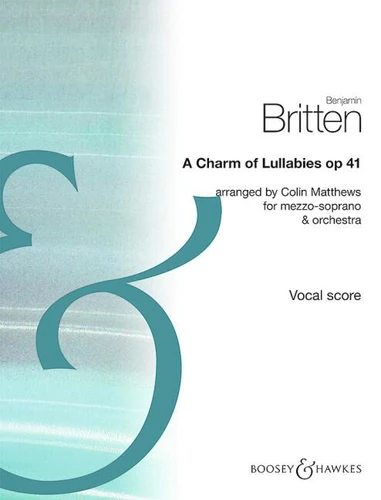A Charm of Lullabies. Arrangement for mezzo - soprano und orchestra. op. 41. mezzo - soprano and orchestra. mezzo - soprano. Réduction pour piano.
Par :Formats :
- Paiement en ligne :
- Livraison à domicile ou en point Mondial Relay indisponible
- Retrait Click and Collect en magasin gratuit
- Réservation en ligne avec paiement en magasin :
- Indisponible pour réserver et payer en magasin
- Nombre de pages32
- Poids0.123 kg
- Dimensions23,1 cm × 30,3 cm × 0,0 cm
- ISBN978-0-85162-787-8
- EAN9780851627878
- Date de parution01/01/2013
- CollectionCHANT
- ÉditeurBOOSEY
- MusicienColin Matthews
Résumé
'A Charm of Lullabies' was written in December 1947 for the mezzo-soprano Nancy Evans. Keen to provide her with a work for her recital programmes, Britten was helped in the choice of texts for 'A Charm of Lullabies' by Evans' husband Eric Crozier, who had recently written the libretto for Albert Herring. The work brings together an anthology of diverse texts unified by the themes of night and sleep and is one of the most genial and uncomplicated of Britten's song-cycles.
Colin Matthews's arrangement differs in several respects from the original piano version, in particular by expanding it to give it the extra dimension needed for an orchestral song-cycle, and by joining the first three songs, and the fourth and fifth, in effect presenting the cycle in two parts. Instrumentation : mezzo-soprano and orchestra op. 41
Colin Matthews's arrangement differs in several respects from the original piano version, in particular by expanding it to give it the extra dimension needed for an orchestral song-cycle, and by joining the first three songs, and the fourth and fifth, in effect presenting the cycle in two parts. Instrumentation : mezzo-soprano and orchestra op. 41
'A Charm of Lullabies' was written in December 1947 for the mezzo-soprano Nancy Evans. Keen to provide her with a work for her recital programmes, Britten was helped in the choice of texts for 'A Charm of Lullabies' by Evans' husband Eric Crozier, who had recently written the libretto for Albert Herring. The work brings together an anthology of diverse texts unified by the themes of night and sleep and is one of the most genial and uncomplicated of Britten's song-cycles.
Colin Matthews's arrangement differs in several respects from the original piano version, in particular by expanding it to give it the extra dimension needed for an orchestral song-cycle, and by joining the first three songs, and the fourth and fifth, in effect presenting the cycle in two parts. Instrumentation : mezzo-soprano and orchestra op. 41
Colin Matthews's arrangement differs in several respects from the original piano version, in particular by expanding it to give it the extra dimension needed for an orchestral song-cycle, and by joining the first three songs, and the fourth and fifth, in effect presenting the cycle in two parts. Instrumentation : mezzo-soprano and orchestra op. 41











